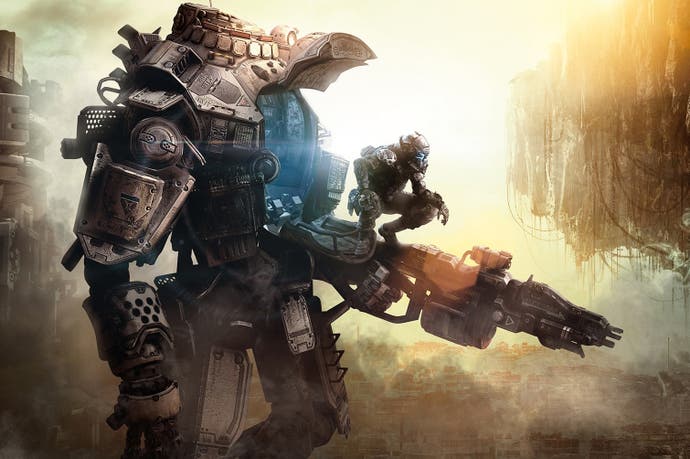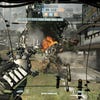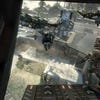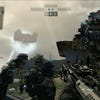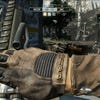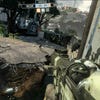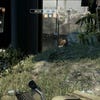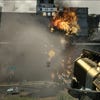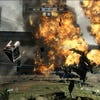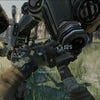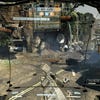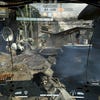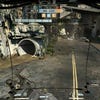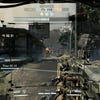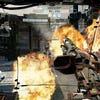Tech Analysis: Titanfall
Digital Foundry's take on the new shooter from developers who wrote the book on console 60fps gunplay.
With the deluge of next-gen shooters such as Destiny, Killzone: Shadow Fall and The Division content to stick to a 30fps baseline, it's clear that the ramp-up of environmental scale, higher grade effects and online integration perhaps excites developers more than slick frame-rates. However, given the yearly sales domination of 60fps franchises like Call of Duty this isn't necessarily the next-gen reality for which some gamers had hoped - even though luminaries like John Carmack suggested that this may be the case. In response, Respawn Entertainment comes from the shadows with its debut sci-fi first-person shooter, Titanfall. Described as a multiplayer-only experience for Xbox One, Xbox 360 and PC, the team builds on a well-established pedigree in console FPS design by working from a "60fps first" template - adding frills only where it fits around that core ideal.
Looking at the birth of the project it's a surprise to find that, of all the engines it could pick, Valve's Source engine comes up top of its list - though there are many reasons why this makes sense. Firstly, it has allowed a relatively small team to get production of the game up and running quickly, having begun the project in earnest under three years ago. Advantages of using the engine also include strong support for networked play, low latency controls owing to a streamlined rendering pipeline, compatibility with multi-core setups, and excellent optimisation for x86 platforms.
This adds to the prospect of an eventual PS4 release, being designed to that very architecture, though currently Respawn remains coy on the point of any Sony-bound ports, only stating that "it's definitely not out of the question" for the future. A timed exclusive is perhaps the likeliest scenario here, so we suspect that it's just a matter of how much sand remains in the hourglass.
Curiously, the biggest deciding factor in going with Valve's tech now has little bearing on its development. During an interview with Polygon, Respawn software engineer Richard Baker says the original reason the team went with the Source engine had much to do with wanting "an engine that would work with PS3, because that's the riskiest platform in current-gen". The call came following the high quality delivery of Portal 2 on PS3 back in 2011, but with next-gen platforms looming large, the project quickly jumped ship to Xbox One. Since this switch-over, large portions of the code have been rewritten to better suit the idea of subsuming a single-player narrative into a multiplayer-only design, and to also better take advantage of Microsoft's much-vaunted cloud compute features.
"Respawn initially chose the Source engine owing to the tech's excellent performance on PS3 - ironic, bearing in mind that the game stands revealed as a Microsoft console exclusive."
Armed with both a trailer and gameplay demo to close Microsoft's E3 conference, Respawn shows off a frantic 7v7 domination match unfolding across a beautifully detailed map called Fracture. The level design is clearly laboured over, balancing three co-existing forces on the battlefield: the human-controlled Pilots, ambient AI characters, and the eponymous Titans. The broad view of the village is certainly impressive by current-gen standards, being surrounded by details such as stepping-stones, trees and cliff ridges - but largely over-shadowed by airship battles raging on the horizon. Draw distances are stand-out, and demonstrate an emphasis on environmental scale in the spirit of Bungie's Destiny. However, it's a more vertical game by nature compared to most shooters, with the squad descending from dropships in jet-packs, and then base-jumping against billboards with snappy animations that should bear exhaustive repetition.
Perhaps revealing its original inspiration, this opening sequence plays out in the style of Valve's Left 4 Dead series, with a squad of seven dropping into a battlefield following a briefing - the goal being to get to a similar "collection" cinematic by the end. To set the warring scene, significant hero characters bark out commands from Titans and via your HUD, while other AI soldiers engage the battlefield in scripted brawls and skirmishes. These CPU characters are essentially cannon fodder for regular players, but also potential allies who can be converted to your side, if hijacked with a Data Knife. The use of the Xbox One's dedicated servers suits this single-meets-multiplayer design nicely. In theory, it means all AI actions are better synchronised for each player in a party, rather than having every interaction pass through a host and thus incur lag for the client majority.
However, the actual benefits of Xbox One's cloud computing remain uncertain. The promise is that AI and physics calculations are handled remotely, from the 300,000 servers set up by Microsoft's cloud service, Azure. News that a 360 version is also in the works by a different, as-yet unnamed studio, raises many questions as to how such exclusive next-gen features will work for older tech - if it all - and whether the PC version matches up in this sense as well.
"Titanfall's exact cloud utilisation remains an enigma. The promise is that AI and physics calculations are handled remotely, from the 300,000 servers set up by Microsoft's Azure service."
Looking for practical evidence of it during the demo, the AI element is accounted for by the many CPU players, whose decisions can feasibly be determined by a remote, host machine. On the other hand, physics-based interactions are kept to such a bare minimum in Titanfall that it's not clear where any external influence comes into effect. The demo shows a largely static level by design, with no procedural damage to the environment in the manner of Battlefield 4 or The Division, nor rag-doll physics - everything is set in stone, and not even the grass or trees animate. Even so, the chosen level speaks volumes about Respawn's art direction, eschewing the deep brown and green hues of its Modern Warfare titles for something with a broader, more colourful palette.
The Spring 2014 release date suggests the fundamentals of Titanfall's design are a lock, but in terms of aesthetics there's plenty to admire already. Despite the map's scale, extra details have been layered across the Fracture stage in multiple passes, down to the rubble of ruined buildings and slanted portraits in higher-end dwellings. The use of colour-coding ties the stage's look together, which in conjunction with high dynamic range, makes both indoor and outdoor areas feel lived-in and organic. Given how the Source engine's last task on console was to realise a simple-but-effective, clinical aesthetic in Portal 2, it's nice to see the tech being put to use with some ambitious backdrops too. From afar, these elements harmonise to produce one of the more astonishing looking games in the next-gen line-up.
In the pursuit of 60fps, something has to give way though - and it usually comes to light when looking too closely. It's the uncanny facial animations during NPC briefings, the rough-looking textures on Titan interiors and billboards, and what seem like scaling artifacts that betray either Titanfall's early development status, or its commitment to being about gameplay first, appearances second. The jaggies are a curious point in particular; even judged by the high quality feed we have availability direct from the Microsoft E3 conference there's more sub-pixel shimmering and rough edges than any other game on show, which suggests this may not be a full-blown 1080p title in its current state. From what Respawn has announced so far, the 60fps bullet-point is proudly announced, but it remains tight-lipped on what native resolution is intended for the final game.
"In action, Titanfall plays to the studio's strengths with fluid reload animations, sharp strafing motions while aboard Titans, and rapid twitches to the reticle during close-quarter encounters."
In action, Titanfall plays to the studio's strengths with fluid reload animations, sharp strafing motions while aboard Titans, and rapid twitches to the reticle during close-quarter encounters. The game moves at an intimidating pace for newcomers, though the addition of Titans is hugely relevant to Respawn's efforts in prolonging the average life-span of each player. The smooth animations seen on these mechanical hulks is especially captivating, with all the metallic joints in its arm shifting downwards to scoop a player up and plant him in a mid-riff cockpit - a transition from Pilot to Titan that's quick, stylish, and unlikely to get old quickly. Peripheral vision is pared back just a touch while docked in here, but it's made up for by some richly detailed interiors. Having played a demo of mech battler Hawken on Oculus Rift, we can't help but hope for HMD support for the final game.
Little is held back in the realm of effects work either. To our count, there's full-screen motion blur, lens flares, plus high grade alpha for sparks, smoke plumes trailing behind rockets, and no restraints on particles spraying from ruined Titan foes - though again, physics-based action seems minimal outside of crumbling machinery. All of these tricks let fly once you down an enemy, seemingly bursting in every direction with unfiltered full-res effects that would surely be toned down for current-gen hardware, or else lose out on that 60fps goal. Even current iterations of the Call of Duty series' multiplayer on 360 and PS3 struggle with bursts of likewise 2D sprites used for smoke grenades, and we suspect this will be one area that Titanfall sees some reductions for its 360 port.
When it comes to that crucial point of performance, Respawn is true to its word in delivering a bridled 60hz response during its E3 demonstration. Not a single frame is repeated over the four minute stretch, producing a monotone reading at the head of the frames-per-second axis. Having double-checked many thousands of these frames by eye after the automated pass, we can confirm that it runs with v-sync engaged at full-blast 60fps regardless of the intensity during battle. It's a hugely promising step forward into the next generation, and starts a movement that is to be followed by the next Halo game and Battlefield 4.
"It remains unconfirmed whether this is running on bona fide Xbox One hardware, or if the Xbox controller prompts seen on-screen are simply a show of gamepad support for the PC version."
However, it remains unconfirmed whether what we're seeing is running on bona fide Xbox One hardware, or if the Xbox controller prompts seen on-screen are simply a show of gamepad support for the PC version. In either case, the game looks impeccably well optimised for 7v7 combat during the chosen stage - a number that may seem on the low side to genre enthusiasts, but immoveable during campaign multiplayer mode given the fine-tuning needed to also balance out AI characters and Titans on the map. However, other stages are set to tweak this number accordingly.
While 60fps is inevitably a slam-dunk for the Source engine if the active hardware here is indeed a PC, it's curious to see Respawn's shorter two-minute trailer, which precedes the gameplay demo, struggling to reach 50fps in spots and showing clearly the devastating effects of double-buffer v-sync when frame rendering runs over the ultra-tight 16.67ms budget. This trailer cuts together a montage of clips to show off more intensive, cinematic scenes alongside gameplay from new levels, where those featuring heavy effects work and broader draw distances visibly suffer from stutter. With one close-up of a Titan descending to just 40fps, it's plausible that some of these scenes are compiled using a much earlier, unoptimised build.
Come Titanfall's Spring 2014 launch, the ideal point of entry for many will be on PC - and pleasingly, you won't require Windows 8 to run it. Bearing in mind a long working history with Valve's immensely scalable Source engine, there should be strong compatibility with a range of PC hardware. Having the game play out over two co-existing scales is sure to be a meticulous balancing act for Respawn though, and the chaotic backdrops and foreground effects lead us to wonder in what cut-down state the Xbox 360 port will launch. For the Xbox One version, however, we're much more assured everything will remain intact. However, we'll have to see whether the flawless performance metrics seen here match up to the real deal nearer release.
Watch Respawn's Titanfall the way it was meant to be seen - at full frame-rate, 60fps - in our recent article on the next-gen 1080p60 dream. It really is quite something.
